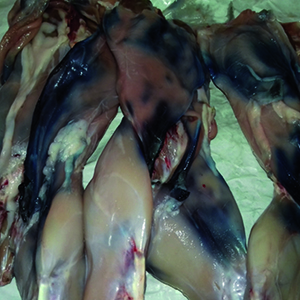Pseudomonas fluorescens group bacteria as responsible for chromatic alteration on rabbit carcasses. Possible hygienic implications

Accepted: 21 February 2022
HTML: 22
All claims expressed in this article are solely those of the authors and do not necessarily represent those of their affiliated organizations, or those of the publisher, the editors and the reviewers. Any product that may be evaluated in this article or claim that may be made by its manufacturer is not guaranteed or endorsed by the publisher.
Authors
Bacteria belonging to the genus Pseudomonas are ubiquitous and characterized by a high adaptation capability to different environmental conditions and wide range of temperatures. They may colonize food, sometimes causing alteration. Quite recently, a blue pigmentation due to Pseudomonas fluorescens has been widely reported in mozzarella cheese. In this report, we describe a blue coloration occurred on rabbit meat stored in the refrigeration cell of a slaughterhouse. The alteration was observed after about 72 hours of storage at 4-6°C. Bacteriological analyses were performed, and a microorganism included in the Pseudomonas fluorescens group was identified. The experimental contamination was planned, using a bacterial suspension with 1x108 UFC/ml load to spread on rabbit carcasses. The blue pigmentation appeared after 24 hours of storage in a cell with the same conditions of temperature. The bacterium was reisolated and identified as responsible for the alteration on meat. These findings highlight the importance of considering the members of the genus Pseudomonas and, more specifically, of the P. fluorescens group when the microbiological quality of food is to be ascertained. In fact, even if these bacteria are not considered a public health problem, their presence should be monitored by food industry operators in self-control plans because they may cause alteration in food. In fact, any altered product should be withdrawn from the market in agreement with Regulation (EC) No 178/2002 of the European Parliament and of the Council.
How to Cite
PAGEPress has chosen to apply the Creative Commons Attribution NonCommercial 4.0 International License (CC BY-NC 4.0) to all manuscripts to be published.

 https://doi.org/10.4081/ijfs.2022.9998
https://doi.org/10.4081/ijfs.2022.9998




